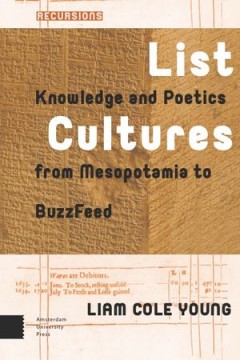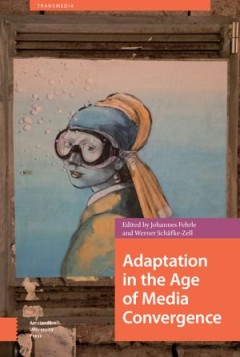Filter by

List Cultures Knowledge and Poetics from Mesopotamia to BuzzFeed
We live in an age of lists, from magazine features to online clickbait. This book situates the list in a long tradition, asking key questions about the list as a cultural and communicative form. What, Liam Cole Young asks, can this seemingly innocuous form tell us about historical and contemporary media environments and logistical networks? Connecting German theories of cultural techniques to A…
- Edition
- -
- ISBN/ISSN
- 9789462981102
- Collation
- -
- Series Title
- -
- Call Number
- -

News Literacy and Democracy
News Literacy and Democracy invites readers to go beyond surface-level fact checking and to examine the structures, institutions, practices, and routines that comprise news media systems.This introductory text underscores the importance of news literacy to democratic life and advances an argument that critical contexts regarding news media structures and institutions should be central to news l…
- Edition
- -
- ISBN/ISSN
- 9781138625051
- Collation
- -
- Series Title
- -
- Call Number
- -

Games and Rules Game Mechanics for the »Magic Circle«
Why do we play games and why do we play them on computers? The contributors of »Games and Rules« take a closer look at the core of each game and the motivational system that is the game mechanics. Games are control circuits that organize the game world with their (joint) players and establish motivations in a dedicated space, a »Magic Circle«, whereas game mechanics are constructs o…
- Edition
- -
- ISBN/ISSN
- 9783837643046
- Collation
- -
- Series Title
- -
- Call Number
- -

Cinematic Rupture; Reading Cambodia’s Genocide through Deleuze and Guattari
This paper will deploy Deleuze and Guattari’s geophilosophy to read the political economy of contemporary Cambodia as a stratum that emerged from the deterritorializing mechanisms of the Khmer Rouge genocide and politicide.
- Edition
- -
- ISBN/ISSN
- -
- Collation
- -
- Series Title
- -
- Call Number
- 371.335 LIM c

Adaptation in the Age of Media Convergence
This collection considers new phenomena emerging in a convergence environment from the perspective of adaptation studies. The contributions take the most prominent methods within the field to offer reconsiderations of theoretical concepts and practices in participatory culture, transmedia franchises, and new media adaptations. The authors discuss phenomena ranging from mash-ups of novels and Yo…
- Edition
- -
- ISBN/ISSN
- 9789462983663
- Collation
- -
- Series Title
- -
- Call Number
- -

Right Across the World: The Global Networking of the Far-Right and the Left R…
In a post-Trump world, the right is still very much in power. Significantly more than half the world’s population currently lives under some form of right-wing populist or authoritarian rule. Today’s autocrats are, at first glance, a diverse band of brothers. But religious, economic, social and environmental differences aside, there is one thing that unites them - their hatred of the libera…
- Edition
- -
- ISBN/ISSN
- 9781786808554
- Collation
- -
- Series Title
- -
- Call Number
- 320 LEF r

From Media Hype to Twitter Storm News Explosions and Their Impact on Issues,…
The word media hype is often used as rhetorical argument to dismiss waves of media attention as overblown, disproportional and exaggerated. But these explosive news waves, as well as - nowadays - the twitter storms, are object of scientific research, because they are an important phenomenon in the public area. Sometimes it is indeed 'much ado about nothing' but in many cases these media storms …
- Edition
- -
- ISBN/ISSN
- -
- Collation
- -
- Series Title
- -
- Call Number
- -

Cyber Public Sphere and Social Movements Calling to Cyber Spaces
The diversification and politicisation of the mass media within itself and also societal pressure created by the mass media at a social level have caused changes to our social structure. The first change began with the contextual changes to the mass media, and this change led to visible changes in societies. That transformation has almost erased the distinction between the private and the publi…
- Edition
- -
- ISBN/ISSN
- 9783848749133
- Collation
- -
- Series Title
- -
- Call Number
- -

Freedom of the Press On Censorship, Self-censorship, and Press Ethics
Since antiquity it has been known that without the freedom to speak, and later to publish, the road to fanaticism and totalitarianism lies wide open. This book focuses on how the 'press' reacted, when press freedom was under strain in number of cases in the 20th century and the beginning of the 21st century. Contemporary literature on the freedom of the press has its focus on the role of the pr…
- Edition
- -
- ISBN/ISSN
- 9783832951849
- Collation
- -
- Series Title
- -
- Call Number
- -

The Democratization of Artificial Intelligence Net Politics in the Era of Le…
After a long time of neglect, Artificial Intelligence is once again at the center of most of our political, economic, and socio-cultural debates. Recent advances in the field of Artifical Neural Networks have led to a renaissance of dystopian and utopian speculations on an AI-rendered future. Algorithmic technologies are deployed for identifying potential terrorists through vast surveillance ne…
- Edition
- -
- ISBN/ISSN
- 9783837647198, 9783839447192
- Collation
- -
- Series Title
- -
- Call Number
- -
 Computer Science, Information & General Works
Computer Science, Information & General Works  Philosophy & Psychology
Philosophy & Psychology  Religion
Religion  Social Sciences
Social Sciences  Language
Language  Pure Science
Pure Science  Applied Sciences
Applied Sciences  Art & Recreation
Art & Recreation  Literature
Literature  History & Geography
History & Geography